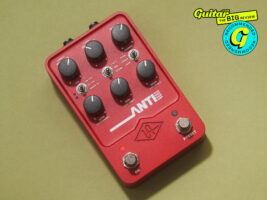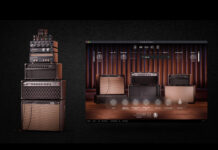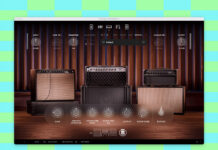
Universal Audio UAFX ANTI review: is this 5150 emulation a full metal rig in one pedal?
You know the score. What the UAFX amp range is has been well-established: Universal Audio picks an amplifier, and then shrinks it down into a dedicated modelling pedal, maybe chucking an amp-appropriate boost in there for good measure. So this must just be business as usual here right? Well, not quite.
READ MORE: UAFX Lion Review: UA’s most raucous amp pedal yet delivers the goods
Because the latest UAFX amp pedal, the ANTI, comes claiming to be a “1992 high-gain amp” – and along with an Eddie-nodding red-and-white colour scheme, we can all quickly surmise that UAFX has fired its shrink-ray at a Peavey 5150. But this marks a rather large shift in where Universal Audio is pitching its pedals.
The first UAFX amps, a trio of vintage combo emulations, were aimed roughly in the direction of old-school rock and blues players – the fact that UA paid Rhett Shull to shoot them out against the real tube deal makes that clear enough, and clearly they found plenty of success going after that audience. It worked well enough that they further enhanced their classic amp credentials late last year when the Lion rounded off the Fender/Vox/Marshall trifecta of classic rock amplification.
But it was pop, ambient and worship players that would become some of the keenest adopters, particularly the Dream and Ruby. The high-fidelity, high-headroom sounds, stereo ins/outs and discrete form-factor meant they were great additions to boards already stuffed with ambient stalwarts like Chase Bliss and Strymon – or, indeed, UAFX’s own delays and reverbs. Within the amp-modelling world, UA has carved out a comfortable, Instagram-friendly low-gain niche, as evidenced by the kinds of guitar pedalboards it reposts on its own feed.
View this post on Instagram
A post shared by Universal Audio (@uaudio)
And so we come to the ANTI. Compared to the above approach to guitar, a 5150 emulation is a dramatic tonal and cultural lurch down the left-hand path. It’s an amp that’s long defined the sound of broad swathes of metal, from chaotic Scandinavian death to tight modern metalcore, and basically everything in between. Boosting a 5150 with a Tube Screamer and applying a tight gate – and not much else – is a quick way to get very close to the sound of a huge amount of modern metal.
And despite the EVH nod in the colour scheme, UA is clearly aiming to offer that particular approach in a single package. The default on-board boost is a Tube Screamer emulation, there’s an integrated noise gate and a bunch of presets designed by the likes of Jeff Loomis. As the demo video makes clear, the intended use case isn’t really players who want to chuck a Hot For Teacher cover into the set…
It makes sense as an addition to the range, as high-gain players have long embraced the direct approach – but not quite in the same way as a UAFX pedal calls for. You’re much more likely to see a single compact unit like a Quad Cortex or an HX Stomp at the feet of a metal guitarist, rather than the sorts of boards you normally see surrounding UAFX Dreams and Rubys.
Essentially, Universal Audio has built up a rather dedicated fanbase for its amp pedals, to the point where it’s not entirely uncommon to see multiple on the same board. But on the face of it, the ANTI doesn’t fit neatly into that ecosystem, unless your setlist goes straight from How Great Thou Art to Steelbath Suicide. So the brand might not have as much of a captive audience for the ANTI built in – can it perform a hellwards handbrake-turn and win over the metalheads?
Image: Adam Gasson
Does the UAFX ANTI sound good?
I do have my well-documented frustrations with the UAFX line’s idiosyncrasies (which we will get onto), but these have often been overshadowed by the excellence of the sounds. And while the ANTI doesn’t really do anything about those quibbles, I am happy to report that the tones here are unbelievable. The ANTI is an absolute joy to play, and as UA has proved time and time again it’s a dab-hand at capturing the sound and feel of an amplifier digitally.
The cleanest cleans are inevitably sterile. But let’s be honest, no one fell in love with the 5150 for its deep, three-dimensional chime – they’ll do the job for the odd melodic interlude, so that’s all fine. The Crunch and Lead channels are what we’re here for, and they immediately up the saturation ante – on full whack, both offer more distortion than you would ever really need.
But, of course, here we can turn to the collective wisdom of the metal community – backing the gain off to about halfway on either the Lead or Crunch channel, set that virtual Tube Screamer to max output, minimum gain and tone to taste, and you have the modern metal tone. It’s saturated without being messy, and (as long as you’re ready to tweak the presence control), bright without being punishing, and thick without being overly bassy and messy.
The noise gate also goes a long way to make the playing experience tight and flub-free – by default its set to its fastest attack and release, and it’s suitably aggressive for speedy playing, but I never found it choked notes where I didn’t want it to.
It’s no surprise that a lot of the presets seem to be a variation on this particular setup. There is something magical about a high-gain tone where the bass is totally under control but still incredibly present – it just makes you want to tune to drop B and play fast, silly riffs all day.
Image: Adam Gasson
Can the UAFX ANTI take a HM-2?
I am curious how well the ANTI takes real pedals, even if you likely won’t need much more overdrive than the on-board Screamer. So what better stress test for that particular task than the inimitable Boss HM-2? Well, the good news is that the ANTI chainsaws with the best of them. With the HM-2 on the legally-obligated settings (everything on max), the noise gate does have to be set to full, but that done, and the ANTI set to a mid-gain overdrive I get an absolutely deliciously evil chainsaw sound.
The slightly odd “resonance” control is handy here, as it shapes the low-end character of the virtual power-amp (a little like the inverse of a presence control), helping to control any excess of low-end, but never scooping so much out that it becomes grating and fizzy.
I do have to admit that I was mildly sceptical about the ANTI, and UA’s ability to move from 50s and 60s rock amps to something so outwardly metal, without the brand evoking Steve Buscemi in a “music/band” t-shirt. But, at least sonically, that scepticism was unwarranted – the ANTI is not messing about. The 5150 is such a ubiquitous amplifier in metal that if you spent half your teenage years listening to Gojira at full blast (hello!), the sound of one coming at you through headphones is just nice and familiar. For me, the ANTI scratched that itch.
Image: Adam Gasson
Is the UAFX ANTI easy to use?
A change in sound hasn’t meant any change to how UA approaches laying out controls. As with the rest of the range, we have three toggles and six knobs, with UA having to make a few decisions as to what controls to include on the face of the pedal, and what controls to bury in the app.
The good news is that, broadly, the essentials are accessible without your smartphone. The amp’s gain, three-band EQ, presence and volume are on the main control layer, and the secondary layer allows you to adjust the noise gate threshold, the resonance of the amp, and the virtual overdrive’s output, gain and tone. And you can also save a preset, choose between the three channels and scroll through the six available cabinets. For my money, that’s all the things you’d actually need on the fly – the rest are more in-depth tweaks that you could feasibly set and forget.
Connectivity is what we’ve come to expect from any UAFX unit – stereo ¼” inputs, stereo ¼” outputs, and that’s it. And, inevitably, there’s been no addition of any sort of MIDI, headphone jack, or the ability to use the USB-C port for interface and/or control purposes… even though we can see a lot of these things on amp-pedals that are less than half the price. But it still bears repeating – I will continue to mention these things every time I review a UAFX pedal, because they’re still really weird omissions.
Image: Adam Gasson
Does the UAFX Control app work?
The lack of USB-C control is, as ever, particularly teeth-grinding, given that to access the deeper settings, you still need to use the UAFX Control mobile app. When I took a look at the UAFX Lion, this app was still in a fairly sorry state; it had seen some minor stability improvements, but the bar was low enough to begin with that we’ve now only just arrived at “mostly functional, once you’re connected.”
And there we remain. I can only tell you about my own experiences with an Android phone – the UAFX forums, and some official communication from UA therein, seem to hint that an iPad is the ideal device for the app – but, you know. C’mon. In my case, connecting to the pedal was pretty tricky initially, and once I had got a connection established, it would break if I left my phone alone for just a few minutes to, well, play the guitar. Reconnecting would potentially require restarting the app and rebooting the pedal, lest I become stuck in a loop of error messages.
Once I manage to get and stay connected, the app functions a bit smoother as I load presets and adjust the deeper settings of the noise gate, tube bias and footswitch behaviour. Here I can also choose some alternative models for the preamp, and switch to a flatter-voiced overdrive rather than the default mid-hump one. When the app works, it’s fine. It’s just a shame that it’s still a coin-toss whether it will stay connected or boot me back into an error-loop if I happen to offend the app in some way.
Image: Adam Gasson
Who is the UAFX ANTI for?
With all of this in mind, it’s time to return to the fact that the ANTI is a sort of de-facto outlier from both modellers in general and the rest of the UAFX amp lineup. Because in its totality it puts a mixed message across: the on-board gate and Tubescreamer mean that, tonally, it could be a complete all-in-one basic metal rig. A lot of players wouldn’t need any more sounds than what the ANTI can offer – in contrast to how, say, the Dream’s target audience might also want to add a few overdrives, reverbs and delays to their setup.
But then this is somewhat undone by the UAFX format itself. You may not want any other sounds, but you’ll need to add a tuner, some way to get the sounds into headphones if you want to practise, an audio interface if you want to record, a DI box if you want XLR outputs, and ideally an iPad if you want to edit any deep settings with any level of consistency. And if you want to sync preset changes to a backing track, well – you can’t.
The fact that there’s not even any power supply in the box of a $399 pedal makes it clear that, despite the all-in-one sounds, it’s far from an all-in-one product. In some ways, it undermines the convenience of having a direct solution at all, when there are other similarly-powerful amp modellers out there that are far more user-friendly – and not much pricier.
But ultimately, this is all par for the course with the UAFX ecosystem. Accepting that the ANTI is the ANTI, and therefore it is what it is and isn’t what it isn’t, will allow you to enjoy some spectacular sounds. A mini board with the ANTI, a tuner and something like a delay to give solos a bit of a lift could very much be all you need – if the circumstances are right.
Image: Adam Gasson
UAFX ANTI Alternatives
There are a good amount of alternatives to the UAFX ANTI, depending on what you need. If you’re on a bit of budget, the Boss IR-2 is a good deal cheaper, and comes with a bevy of high-gain options, even if they’re not quite as high-fidelity. There’s also the TC Electronic’s Ampworx 550, which is also aiming to be a 5150 in a box with a boost and a cab sim, albeit a lot more straightforward and a lot more affordable.
Alternatively, if you want some more flexibility, both the Line 6 HX Stomp and the IK Multimedia ToneX pedal can chug with the best of them, and come with the benefit of boasting a huge library of amp and effects models.
The post Universal Audio UAFX ANTI review: is this 5150 emulation a full metal rig in one pedal? appeared first on Guitar.com | All Things Guitar.
Source: www.guitar-bass.net












